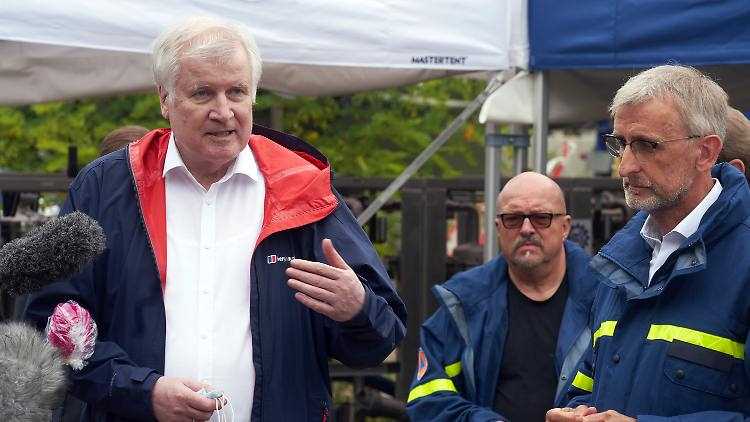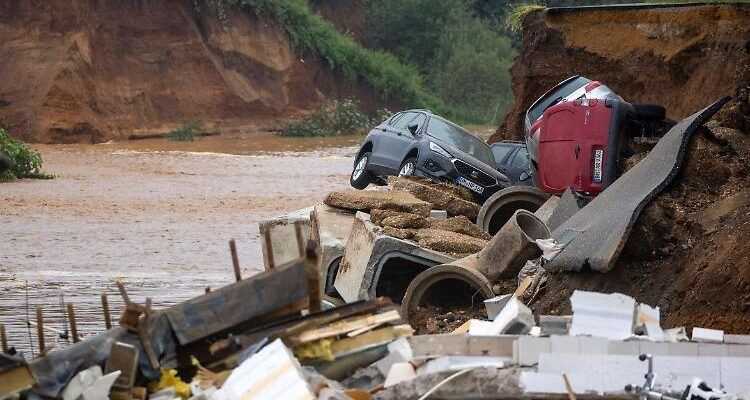Monday, July 19, 2021
“Small mistakes, extreme effects”
Why didn’t sirens warn of the flood everywhere?
From Roland Peters
Everyone wants to have done everything right before the flood disaster. But more than 160 people are dead. Hundreds are still missing. The fault is apparently in the system.
Many people know this from their own childhood: the sirens wail, one is frightened, but the parents are not, because it is only the regular test alarm for an emergency. The real thing was nuclear bombs that used to fall and other military attacks. But the decades-long Cold War vanished into thin air after German reunification. The capitalist West and the Eastern bloc were no longer open enemies of the system. With the omnipresent conflict, part of civil protection also disappeared. And, specifically, the wailing sirens in many places.
During the current flood disaster, the warning systems did not work properly. Federal Interior Minister Horst Seehofer and the Federal Office for Civil Protection and Disaster Relief, which is subordinate to him, reject the guilt. But something must have gone wrong: More than 160 dead, hundreds of missing people and destruction of ghostly proportions speak for themselves. There is a huge problem with disaster control.
In the current flood disaster, federal states, cities and municipalities were responsible for evaluating the warnings from the German Weather Service and passing them on to those affected. However, this was evidently done inappropriately. The procedures are not standardized. Sirens only wail where there are still some. The federal government is only responsible for warning the population in the event of war. In the event of great danger, the authorities broadcast their warnings via radio and television. There are also digital warning options via cell phones and other devices.
There were signs that something was crunching in the system. There would be the warning day last September, announced by the Federal Office for Civil Protection and Disaster Relief. At the time of the test, many heard: nothing. The notifications via the warning apps arrived too late or not at all, the sirens in Berlin and Munich, for example, had been dismantled after the end of the Cold War. The then head of the authorities, Christoph Unger, complained that the employees and departments involved simply did not adhere to the agreements. He had to go anyway.
“Broken Chain Links”
The failed endurance test demonstrably did not learn (quickly) enough. According to Professor Hannah Cloke, who helped set up the European warning system European Flood Awareness System, or “Efas” for short, after the flood in 2002, the authorities were notified for the first time on the weekend before the tidal waves. The information about the endangered locations became more precise every day, similar to a weather forecast. According to Cloke, the mistake was in the transmission of information: “There are broken chain links. So many deaths in 2021 are unacceptable. Something is wrong with the system,” says the scientist quoted by the BBC.
The state German Weather Service had sent out timely notifications of extreme rainfall, but is not responsible for warning the local population. Authorities used to be able to wail sirens at around 80,000 locations in both east and west. According to the Federal Office for Civil Protection and Disaster Relief, there were only around 15,000 sirens in 2015. In the past, the national governments were responsible, now it is federal states and municipalities. In West Germany, there were ten central warning offices that were supposed to notify people in the event of attacks; for example in the event of an imminent bombing, artillery fire or with nuclear, biological and chemical weapons.
In the meantime, cities and towns are “almost entirely” responsible for the sirens. Many have dismantled, switched off or simply not replaced the acoustic warning systems because of the maintenance requirements. Armin Schuster wanted that to change: The President of the Federal Office for Civil Protection and Disaster Relief wants “the good old siren” back, he said. In recent years, digital warning systems in particular have been set up, said Schuster.

Federal Interior Minister Horst Seehofer (left) and Federal Office President Armin Schuster (right).
(Photo: dpa)
The warning apps are said to be installed on around 9 million devices in Germany. But if the power fails or the cellular network fails, that’s not enough. Schuster wants to combine different warning devices better. There is a federal funding program of 90 million euros for this, but the head of the authorities doubts that this will be sufficient. Above all, it is about sensitizing the population, said Schuster. “What I have no influence on is how it is dealt with on site.”
“We need a big (..) campaign in the next few years, because we will have to continue to expect such extreme weather conditions”, said Wolfram Geier, who heads the department’s risk management department, Deutschlandfunk: “It has not yet really reached people’s consciousness that their little brook, their little river around the corner, can swell within a very short time.”
Slow flow of information
But that’s only part of the truth. Obviously there are sluggish structures in German crisis management. “The information channels are too long, not uniform and in some cases poorly organized,” says Professor Oliver Posegga from the University of Bamberg in an interview with ntv.de. Over the years, the scientist studied in a research project how the flow of information can be improved in the event of a disaster. “The problem does not lie in the technologies used, but in the processes and responsibilities behind them, which are essential for ensuring that the right information reaches those affected in good time.”
In other words, human error is possible in the current case. But it is unclear where. Posegga warns against drawing conclusions too quickly: “We first have to analyze thoroughly, then understand, learn from the findings and, if at all, only draw personal conclusions at the end. Not the other way around.” The facts are therefore not yet completely available. “At the same time, personnel consequences are being demanded while we are still rescuing the dead.” The goal was and is that the warnings reach all those affected in good time. But: “In the case of sudden catastrophes of this magnitude, even supposedly small mistakes can have extreme effects. A few hours matter,” says Pasogga.
Federal Interior Minister Horst Seehofer defended the federal structure of disaster control. It would be inconceivable that the work in such a disaster could be done centrally from anywhere. “Centralism doesn’t improve anything here,” said Seehofer. Only after the aid has been given will it be possible to talk about where improvements are possible and where cooperation can be made closer. The reporting channels, as far as the federal government was responsible, would have worked.
But there may also be a problem. More centralized and standardized processes of crisis management could help to react better and earlier to crises, says scientist Pasogga. “In an emergency, many organizations and those responsible have to coordinate as quickly as possible under extreme conditions,” he knows. “Time and important information can be lost, which can have devastating consequences.” As in the current case.
There is still a means of preventing urgent warnings from getting lost in the mess of communication between those responsible. In the USA, for example, authorities can also send acoustic warnings to cell phones, which can be tough regardless of the operating system, software or settings. In Germany, on the other hand, the silent mode can already render the apps useless. Full sirens may not be such a bad idea after all.
.
